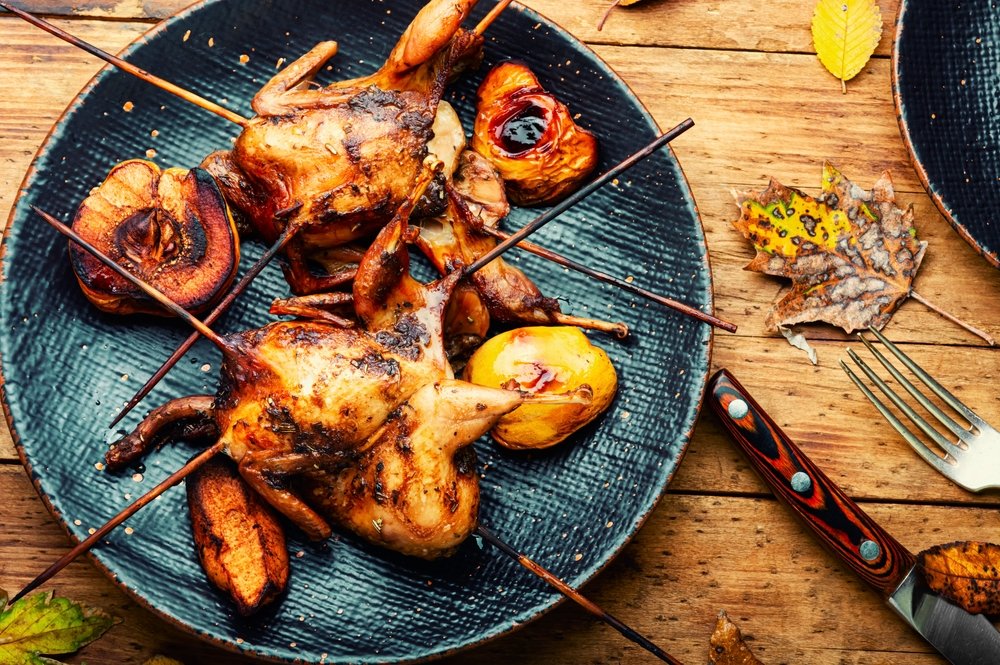Quail Meat: 5 Steps to Perfection and Success
Quail meat, also known as quail poultry, refers to the edible flesh of various species of small game birds belonging to the family Phasianidae. These birds are primarily found in Europe, Asia, and North America.
Quail meat is highly regarded for its delicate flavor, tender texture, and versatility in culinary applications. It is often considered a gourmet delicacy enjoyed by discerning palates worldwide.
Definition of Quail Meat
Quail meat encompasses different cuts obtained from quail, small-sized birds known for their plumpness and succulence. The most common species used for meat production is Coturnix japonica, also called Japanese quail or Jumbo quail. The tender flesh of these birds offers a mild taste reminiscent of chicken but with a slightly gamier note.
Historical Significance of Quail Meat Consumption
The consumption of quail meat dates back centuries and has deep-rooted historical significance in various cultures worldwide. In ancient Egypt, quail were considered sacred birds and were associated with the sun god Ra. They were highly prized not only for their delectable taste but also for their perceived medicinal properties.
In medieval times, quail were cherished by nobility and aristocracy due to their scarcity and unique flavor profile. They became popular game birds during hunting expeditions among European monarchs and wealthy elites who relished the challenge of capturing these elusive creatures.
Quail Species and Varieties
Common species used for meat production (Coturnix japonica)
When it comes to quail meat production, one of the most commonly used species is Coturnix japonica, also known as Japanese quail. This small game bird has been domesticated for centuries due to its fast growth rate and ability to adapt to different environmental conditions.
The popularity of Coturnix japonica can be attributed to its high meat-to-bone ratio, making it a preferred choice for commercial quail farming. Coturnix japonica possesses several key characteristics that make it ideal for meat production.
Firstly, these quail have excellent feed conversion efficiency, meaning they can convert their food into body weight at an impressive rate. They have been known to reach maturity in just 6-7 weeks.
Additionally, the breed has a high egg-laying capacity and produces eggs with delicate shells and rich yolk content. This dual-purpose nature of Coturnix japonica makes it highly valued in the poultry industry.
Unique characteristics and traits of different quail varieties
While Coturnix japonica is widely recognized as the primary species used for meat production, other varieties possess unique characteristics worth exploring. For instance, Pharaoh Quails (Coturnix coturnix) are appreciated for their distinctive plumage patterns and vibrant colors, adding aesthetic appeal to aviaries or ornamental gardens.
These quail also have tender white flesh with a slightly gamier taste than Japanese quail. Another notable variety is the Bobwhite Quail (Colinus virginianus), native to North America.
Although primarily popular among hunters due to their gamey flavor profile and exceptional flying abilities, Bobwhite Quail are occasionally raised for their delectable meat characterized by a rich and full-bodied taste. Moreover, the meat of these quail is lean and tender, making it a delightful choice for culinary enthusiasts.
These examples represent just a fraction of the diverse quail species and global varieties. Each possesses unique traits, from appearance to flavor profiles, allowing individuals to explore the world of quail meat beyond the commonly consumed Coturnix japonica.
Nutritional Value of Quail Meat
High Protein Content and Essential Amino Acids
One of quail meat’s most notable nutritional benefits is its protein content. Quail meat is renowned for being an excellent source of high-quality protein, which plays a crucial role in the growth, repair, and maintenance of body tissues. Proteins are composed of amino acids, and quail meat contains all the essential amino acids the human body requires.
The body cannot synthesize these essential amino acids, which must be obtained through diet. Quail meat is a superior protein source to other meats due to its remarkable amino acid profile.
It contains a well-balanced combination of essential and non-essential amino acids, making it an ideal choice for individuals seeking protein needs. The abundance of essential amino acids in quail meat aids muscle development, supports tissue repair after physical exertion or injury, and helps maintain overall bodily functions.
Low Fat and Cholesterol Levels Compared to Other Meats
For health-conscious individuals seeking leaner meat options without compromising taste or nutritional value, quail meat is an excellent choice. It boasts significantly lower fat levels than other meats such as beef or pork.
This low-fat content makes it a desirable option for weight management and reduces the risk factors associated with cardiovascular diseases. In addition to being low in fat, quail meat contains minimal cholesterol.
Excessive consumption of dietary cholesterol has been linked to increased risk factors for heart disease. However, quail meat’s naturally low cholesterol levels can be included as part of a heart-healthy diet without causing concern.
Rich Source of Vitamins and Minerals (Iron, Zinc, Vitamin B12)
Quail meat is a protein powerhouse and a rich source of essential vitamins and minerals. It provides nutrients vital for various bodily functions, ensuring optimal health and well-being.
For example, quail meat is an excellent source of iron, a mineral crucial for producing red blood cells and preventing iron deficiency anemia. Furthermore, quail meat contains significant amounts of zinc, pivotal in immune function, wound healing, and DNA synthesis.
Zinc also contributes to normal growth and development during childhood and adolescence. Additionally, quail meat is abundant in vitamin B12.
This essential vitamin aids in maintaining healthy nerve cells, supporting brain function, and assisting in the formation of red blood cells. A deficiency in vitamin B12 can lead to fatigue, weakness, and neurological disorders; therefore, incorporating quail meat into one’s diet can help ensure adequate intake of this vital nutrient.
Overall, the nutritional value offered by quail meat makes it an exceptional dietary choice that provides high-quality protein and essential amino acids while being low in fat and cholesterol. Furthermore, its richness in vitamins such as B12 and minerals like iron and zinc contributes to overall health maintenance.
Culinary Uses and Preparation Techniques
Popular dishes featuring quail meat
With its tender and delicate texture, Quail meat has captured the palates of food enthusiasts worldwide. One of the most popular ways to prepare quail is by roasting it.
Roasted quail brings natural flavors while creating a delightful balance of crispy skin and succulent meat. The bird can be marinated beforehand using a mixture of herbs, garlic, lemon juice, and olive oil to infuse it with additional layers of flavor.
Once marinated, it can be roasted in the oven until golden brown and cooked to perfection. Another beloved method of cooking quail is grilling.
Grilled quail offers a slightly smoky taste that complements the meat’s sweetness. To ensure juicy results, it is advisable to butterfly the bird before grilling – this involves removing the backbone and pressing it flat.
This technique allows for even heat distribution and quicker cooking times. Brushing the quail with a glaze made from honey or balsamic reduction during grilling adds an enticing caramelized touch to its already delectable flavor profile.
Different cooking methods for various cuts of quail (breast, legs)
When it comes to cooking different cuts of quail, each requires specific attention to bring out their best qualities. Pan-searing is excellent for succulent and tender breast meat that melts in your mouth. First, season the breasts with salt and pepper or your preferred spice blend.
Heat oil or butter in a skillet over medium-high heat and sear each side for 2-3 minutes until golden brown. Due to their delicate nature, do not overcook them, as they can quickly become dry.
Quail legs, on the other hand, benefit from braising or slow cooking methods. Braising involves searing the legs first to lock in their juices, then simmering them in a flavorful liquid such as broth or wine.
This technique ensures the meat becomes tender and easily pulls away from the bone. As an alternative, slow cooking in a crockpot with some vegetables and herbs allows the flavors to meld together and results in incredibly tender quail leg meat.
Marinating techniques to enhance flavor and tenderness
Marinating quail adds depth of flavor and helps tenderize the meat for a more enjoyable dining experience. Various marinade options can complement different taste preferences.
One popular marinade for quail is a combination of soy sauce, honey, garlic, ginger, and a splash of sesame oil. The soy sauce adds umami richness while the honey balances it with sweetness.
Garlic and ginger infuse their aromatic notes into the meat, while sesame oil adds a layer of nuttiness. If you prefer a Mediterranean twist, consider marinating quail with olive oil, lemon juice, fresh herbs like rosemary or thyme, crushed garlic cloves, salt, and pepper.
This citrus-infused marinade imparts bright flavors that beautifully complement the delicate nature of quail meat. For those who enjoy bold and spicy flavors, a marinade made with chili peppers (such as jalapenos or habaneros), lime juice, cilantro leaves, cumin powder, paprika, salt, and black pepper can provide an exhilarating kick to your quail dish.
Seasoning options for different culinary preferences
When seasoning quail meat before cooking or serving it as part of a dish or recipe, preparation varies according to personal preference. To bring out the natural flavors of quail without overpowering them with complex seasonings, a simple combination of salt and freshly ground black pepper can work wonders. The subtle seasoning allows the inherent sweetness of the meat to shine through.
Herbs such as thyme, rosemary, sage, and tarragon blend exceptionally well with quail meat. These aromatic herbs add a touch of earthiness and elevate the overall flavor profile without overpowering its delicate nature.
For those who enjoy a little heat and spice, paprika, cayenne pepper, or chili powder can be added to provide an extra kick. Smoked paprika adds a smoky undertone that perfectly complements grilled or roasted quail dishes.
Additionally, consider incorporating spices like cumin, coriander seeds, turmeric powder, or garam masala for an exotic twist for a touch of global flair. These spices add complexity to the dish while creating unique flavor combinations that intrigue your taste buds.
Ultimately, the choice of seasoning depends on personal preferences and desired flavors. Experimenting with different herbs and spices is encouraged to discover delightful combinations that enhance quail meat’s natural qualities while adding a curative touch to each dish.
Health Benefits of Consuming Quail Meat
Promotes Muscle Growth and Repair due to High Protein Content
Quail meat is a powerhouse regarding protein content, making it an excellent choice for those looking to build and repair muscles. Protein is crucial in the growth, maintenance, and repair of body tissues, including muscles.
Quail meat delivers a generous amount of high-quality protein, rich in essential amino acids that the body needs for optimal muscle development. The abundance of protein in quail meat helps stimulate muscle protein synthesis, supporting the growth and recovery after intense workouts or physical activity.
Supports Cardiovascular Health with Low Fat Content and Good Cholesterol Profile
Quail meat is a heart-healthy option due to its low fat content and favorable cholesterol profile. The fat content in quail meat is significantly lower compared to other meats such as beef or pork.
Additionally, the fats present in quail meat are primarily healthy unsaturated fats like omega-3 fatty acids, which have been linked to numerous cardiovascular benefits. These fats help reduce bad cholesterol levels while increasing good cholesterol levels, ultimately promoting heart health and reducing the risk of heart diseases.
Boosts Immune System with Essential Vitamins and Minerals
In addition to its impressive protein profile, quail meat is packed with essential vitamins and minerals supporting a robust immune system. It contains vital nutrients such as iron, zinc, vitamin B12, and vitamin A – known for their immune-boosting properties. Iron is important for red blood cell production, while zinc helps fortify the immune system against infections.
Vitamin B12 plays a significant role in maintaining overall cellular health, while vitamin A supports properly functioning of the immune system’s defense mechanisms. Incorporating nutrient-rich quail meat into your diet can support your immune system, helping you stay healthy and resilient.
Farming Practices for Quail Meat Production
Housing Requirements for Raising Quail
Regarding quail farming, providing suitable housing is crucial to ensure the birds’ well-being and productivity. Quails thrive in clean, well-ventilated environments with adequate space to move around comfortably.
They require housing that protects them from extreme weather conditions and predators while allowing access to natural light. Additionally, nesting areas should be provided for egg-laying quail, ensuring their comfort and encouraging a productive breeding environment.
Feeding Practices to Ensure Optimal Growth
Careful attention must be paid to their feeding practices to achieve optimal growth rates in quail raised for meat production. A balanced diet is essential, consisting of high-quality feed pellets designed specifically for quail.
These pellets provide the nutrients for healthy growth, such as proteins, vitamins, minerals, and amino acids. It is also important to always ensure a consistent supply of clean water, as hydration is vital for the birds’ well-being and overall performance.
Disease Prevention Strategies in Quail Farming
Maintaining hygiene and implementing effective disease prevention strategies are paramount in quail farming. Regular cleaning of the housing area helps reduce the risk of diseases spreading among the flock. Proper biosecurity measures should be implemented to prevent the entry of pathogens into the farm premises through equipment or visitors.
Vaccinations against common avian diseases are critical in preventing outbreaks among quail. Regular health checks by qualified veterinarians can help identify any potential health issues early on and ensure appropriate action is taken promptly.
Environmental Impact of Quail Meat Production
Lower Carbon Footprint Compared to Larger Livestock
Quail meat production has a lower carbon footprint than larger livestock animals such as cattle or pigs. Due to their smaller size, quail require less land, feed, and water resources.
This results in reduced greenhouse gas emissions and a more sustainable farming practice. Choosing quail meat contributes to a more environmentally friendly food system by minimizing the ecological impact associated with intensive livestock farming.
Efficient Land Use due to the Small Size of Quails
The small size of quail allows for efficient land use in meat production. Quail farms can be established on smaller land plots than traditional livestock farms.
This compactness conserves land resources and opens up opportunities for urban farming or agricultural practices in areas with limited space. Quail meat production showcases the potential for sustainable food production even within urban environments, fostering local food systems and reducing transportation.
Cultural Significance – Quail Meat in Different Regions
Traditional Dishes Incorporating Quail
Quail meat has long held cultural significance across various regions, where it is often featured in traditional dishes that showcase local culinary traditions. From Mediterranean-inspired recipes like stuffed quail with aromatic herbs and spices to Asian cuisines that present succulent roasted quail glazed with unique sauces, the cultural diversity reflected in these dishes highlights the versatility and appeal of quail meat as a culinary delight.

Conclusion
Indulging in quail meat not only offers exceptional taste but also delivers a plethora of health benefits. Its protein-rich composition promotes muscle growth and repair, while its low-fat content and favorable cholesterol profile support cardiovascular health.
Furthermore, quail meat’s essential vitamins and minerals strengthen immune systems. Additionally, sustainable practices employed in quail farming help minimize environmental impact through lower carbon footprint and efficient land utilization.
Embracing the cultural significance of quail meat adds an element of diversity to our culinary experiences. So, let’s savor the flavors of quail meat with the knowledge that it not only nourishes our bodies but also contributes to a more sustainable and globally conscious food culture.






